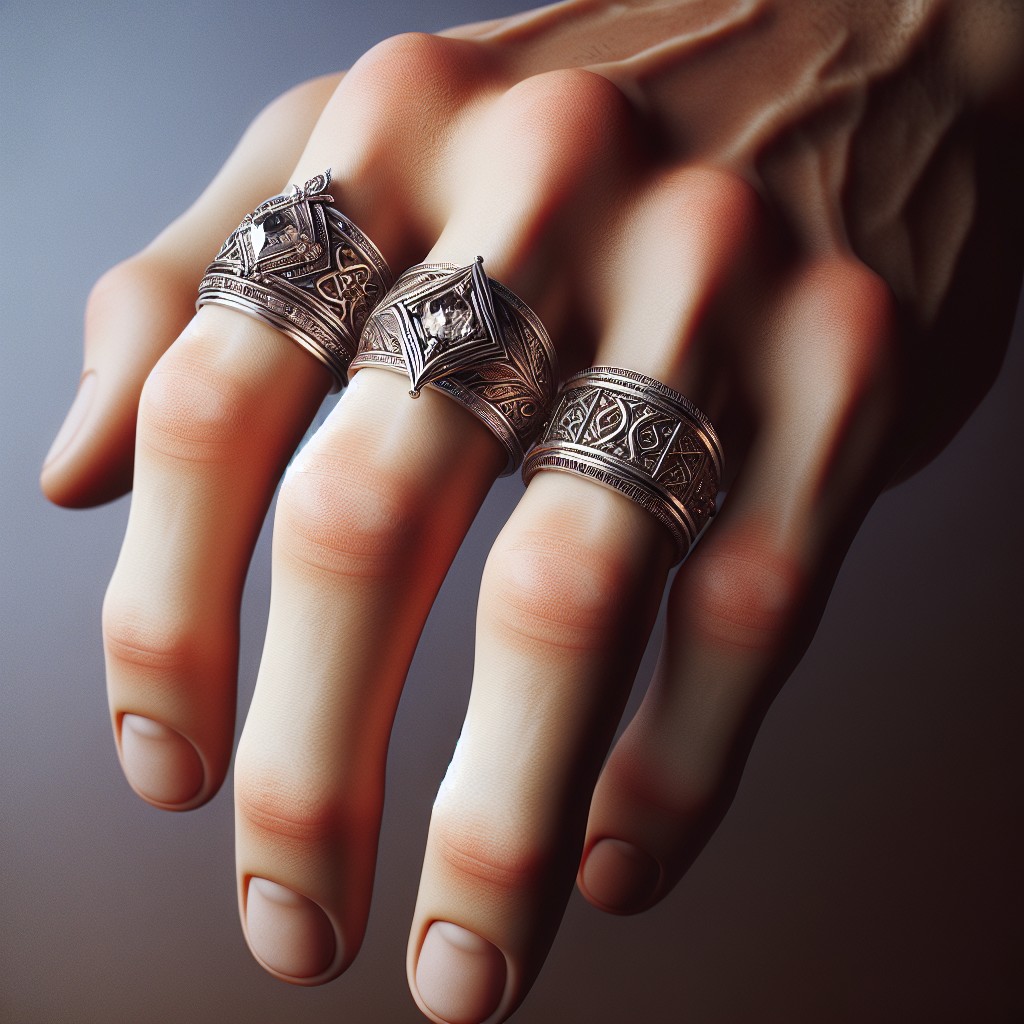Discover the traditional order for wearing engagement and wedding rings, and learn why this custom is significant in symbolizing your journey from proposal to marriage.
Key takeaways:
- Engagement rings symbolize a promise of marriage.
- Wedding rings solidify the vows taken during the ceremony.
- Engagement rings are typically more ornate, while wedding bands are simpler.
- The tradition of wearing rings originates from ancient Egypt.
- The order of wearing rings can be flexible and based on personal preference.
History and Symbolism

Tracing back to ancient Egypt, the tradition of exchanging rings as a symbol of love and commitment has been around for thousands of years. Egyptians believed the ring’s circular shape represented eternity, with no beginning or end, much like the concept of love. Romans later adopted this tradition, using the placement of the ring on the fourth finger of the left hand, owing to the belief in the “vena amoris” or “vein of love” directly connecting to the heart. This romantic notion has endured through the ages.
The engagement ring, typically featuring a diamond or other precious stone, signifies a promise of marriage. It is a declaration of one’s intent to join lives with their partner. The wedding ring, often a simpler band, is exchanged during the wedding ceremony to solidify the vows taken, serving as a physical representation of the marriage itself.
Throughout history, these symbols have evolved but the core signification of commitment, love, and partnership remains central to their meaning. These rings are not mere ornaments but are deeply rooted in the expression of enduring unity between two individuals.
Engagement Ring and Wedding Ring Differences
Understanding the distinctions between engagement and wedding rings helps in appreciating their significance. Typically, an engagement ring is presented at the proposal or soon after, symbolizing a commitment to marriage. These rings often feature a prominent gemstone, commonly a diamond, and are worn on the ring finger of the left hand.
On the other hand, wedding rings are exchanged during the marriage ceremony, representing the official bond and union between the couple. They are usually simpler in design, often a plain metal band or one adorned with smaller diamonds or other gemstones, reflecting the enduring nature of the marriage.
Whereas engagement rings are focused on aesthetic appeal and tradition, wedding bands emphasize the lasting covenant and are designed for everyday wear since they are often less ornate and more durable. While both rings are meaningful, they serve different purposes in the journey from proposal to marriage.
The Tradition of Wearing Rings
The custom of wearing rings has a rich history, originating from ancient Egypt where rings were used as symbols of eternity. Through time, these bands made their way to ancient Rome and Greece, evolving into tokens of love.
During the Renaissance, the gimmel ring, consisting of two interlocking bands, gained popularity. These were worn separated during the engagement and then united at the wedding ceremony, symbolizing two lives joining together.
In some cultures, the right hand is considered the ‘active’ or ‘physical’ hand, often chosen for engagement rings to signify the forthcoming union. Conversely, the left hand’s association with the heart, thanks to the belief in the ‘vena amoris’ or ‘vein of love’, makes it the traditional place for the wedding band.
This established order underscores the progression from engagement to marriage, reflecting the journey from promise to commitment.
The Wedding Day: Engagement Ring and Wedding Band Order
On the day of the wedding, tradition typically calls for brides to wear their wedding band closest to their heart, meaning it should be placed on the finger before the engagement ring. To follow this custom, many brides temporarily move their engagement ring to their right hand, or even leave it off until after the exchange of wedding rings during the ceremony.
This allows the wedding band, often a simpler band, to be placed onto the left ring finger first. Once the ceremony concludes, the engagement ring can be returned to its position alongside the wedding band. Some also choose to have the engagement ring and wedding band soldered together before the wedding to ensure proper placement and ease of wear.
The key is to remember that these guidelines are flexible and personal preferences can dictate the final arrangement.
Common Practices and Personal Preference
Throughout different cultures, the left hand is traditionally seen as the home for both engagement and wedding rings due to the belief in a vein that runs directly to the heart. Despite this, variations exist globally – some wear the engagement ring on the right hand, moving it to the left to make way for the wedding band during the ceremony.
Others stack them on the same finger, with the wedding band first, placed during the ceremony, followed by the engagement ring. This order signifies the wedding band being closer to the heart, echoing its importance and unbroken commitment.
However, it’s also not uncommon for spouses to wear their rings on separate fingers, or even on different hands, after the wedding based on comfort, occupation, or aesthetic preferences.
Engagement rings are often more elaborate, so some may choose to wear them alone for certain activities while keeping the more understated wedding band on regularly.
The beauty of modern marriage is its adaptability. Couples have the freedom to choose how to wear their symbols of love in a way that best reflects their personal style and the unique narrative of their relationship.



